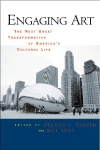« Audience as Orchestra? | Main | An audacious new world of creativity? »
June 16, 2007
The European model
by Robert LevineWilliam Osborne wrote (in a comment):
I hate to speak in such blunt terms, but the naivety of this discussion is appalling, even if based on very common American delusions. You refuse to admit that our problems with the performing arts are systemic, due to our lack of public arts funding. It really is a form of willful denial with the result that your views are not only blinkered, they reflect a chauvinistic ethnocentricity....The USA is the ONLY industrial country in the world that does not have extensive public funding for the arts. You all accept this extremism as if it were normal and confine your thinking to this absurd paradigm. As arts journalists you should be the first to protest our lack of public funding for the arts. You should be the first to open discuss how the lack of public funding contextualizes all of the problems and challenges you are discussing. So why all the silence?
Actually the US does have extensive public funding for the arts. But it's done by tax policy rather than direct funding. It probably doesn't provide as much funding for the arts per capita as does the direct subsidies in some (not all) European countries. But it provides far more money for the arts than any other mechanism that any conceivable constellation of political forces in the US could achieve.
I'd love to have the kind of public funding that German orchestras have. It's going to happen in the same millennium that the Berlin Bombers have the best record in baseball.
Posted by rlevine at June 16, 2007 1:30 AM
COMMENTS
Thank you for your comment, Robert. Your suggestion that tax policy provides extensive public funding for the arts in America is simply not true. To make this assertion you should provide the actual numbers - and for more than one or two communities such as Minneapolis or San Francisco which represent only a tiny fraction of our population.
I have noticed that Americans often try to squirm out of international comparisons regarding arts funding by stating plainly false facts. One of the most common is listing numbers for the huge number of orchestras we supposedly have without noting that the vast majority of them are low paying semi-professional groups. And opera houses in our country are virtually non-existent. So where is the "extensive public funding based on tax policy" going? There must be an awful lot of phantom opera houses around here!
And why the fatalistic attitude about increasing our public arts funding? What kind of leadership is that? I am sure people told Martin Luther King that blacks would achieve equality about the same time the US team wins soccer's World Cup. That might be true, but it didn't stop him from making significant progress for his people. Social justice is always a slow process. It doesn't happen if there aren't individuals with the guts and determination to make the first steps.
During the Roosevelt administration the US moved toward forms of social democracy similar to what all other industrial countries have. That work and those policies have been systematically destroyed over the last 60 years to the point that US economic policy quite literally represents an isolated form of extremism. Social conditions such as 40 million people without health insurance, our massive ghettos, our high school graduation rate of only 70%, our lack of mass transit, and our out-of-control military-industrial complex prove the point.
The problems with public arts funding can indeed be solved. It will be a long-term struggle, and it will require leaders like you, Robert, and the others on this panel. So take heart and get busy!
William Osborne
William@osborne-conant.org
www.osborne-conant.org
Posted by: William Osborne at June 16, 2007 6:16 AM
Post a comment
Tell A Friend
Resources
Engaging Art: The Next Great Transformation of America's Cultural Life Chapter downloads MP3s Vanessa Bertozzi on audiences and participation Vanessa Bertozzi on involving artists in work Steven Tepper argues the historical context of arts in America
Abstracts
Chapter 4
In & Out of the Dark - (a theory about audience behavior from Sophocles to spoken word)
Chapter 7
Artistic Expression in the age of Participatory Culture (How and Why Young People Create)
Chapter 8
Music, Mavens & Technology
(all chapters in pdf form)
Steven Tepper talks about technology and the future of cultural choice
Lynne Conner on the historical relationship between artist and audience
Lynne Conner on event and meaning and sports
AJ Blogs
AJBlogCentral | rss
culture
Terry Teachout on the arts in New York City
Andrew Taylor on the business of arts & culture
rock culture approximately
Rebuilding Gulf Culture after Katrina
Douglas McLennan's blog
Art from the American Outback
Scott McLemee on books, ideas & trash-culture ephemera
Jan Herman - arts, media & culture with 'tude
dance
Apollinaire Scherr talks about dance
Tobi Tobias on dance et al...
media
Jeff Weinstein's Cultural Mixology
Martha Bayles on Film...
music
Greg Sandow performs a book-in-progress
Howard Mandel's freelance Urban Improvisation
Focus on New Orleans. Jazz and Other Sounds
Exploring Orchestras w/ Henry Fogel
Kyle Gann on music after the fact
Doug Ramsey on Jazz and other matters...
Greg Sandow on the future of Classical Music
Norman Lebrecht on Shifting Sound Worlds
publishing
Jerome Weeks on Books
visual
Public Art, Public Space
John Perreault's art diary
Lee Rosenbaum's Cultural Commentary
Tyler Green's modern & contemporary art blog
Special AJ Blogs
June 14-20, 2007



